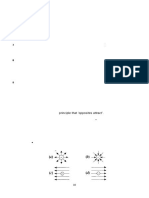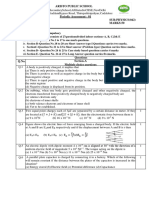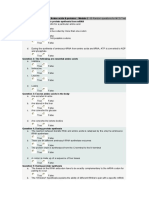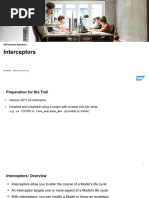Worksheet 01 Phy (2021) STEP
Worksheet 01 Phy (2021) STEP
Uploaded by
kirki pCopyright:
Available Formats
Worksheet 01 Phy (2021) STEP
Worksheet 01 Phy (2021) STEP
Uploaded by
kirki pCopyright
Available Formats
Share this document
Did you find this document useful?
Is this content inappropriate?
Copyright:
Available Formats
Worksheet 01 Phy (2021) STEP
Worksheet 01 Phy (2021) STEP
Uploaded by
kirki pCopyright:
Available Formats
WORKSHEET-1
PHYSICS Unit-6
Worksheet-01
Topics:- Coulomb’s Law, Electric Field Strength, Electric
Potential & Potential Gradient, Electric field due
to an infinite sheet of charge and between two
oppositely charged parallel plates
USE THIS SPACE FOR
Q.1 The Coulomb’s law is: SCRATCH WORK
1 q1q 2
F rˆ
4 r 2
The units of “ ” are:
A) N m-2 C-2 C) N-1 m-2 C2
B) N m-2 C2 D) None of these
Q.2 The study of charges at rest under the action of electric
forces is called:
A) Electromagnetics C) Electricity
B) Electrostatics D) None of these
Q.3 The existence of an object is primarily because of:
A) Magnetic force C) Gravitational force
B) Electric force D) Nuclear force
Q.4 Which one is sure test for the presence of charge on a
body?
A) Attraction C) Both A and B
B) Repulsion D) None of these
Q.5 Coulomb’s force:
A) Obeys inverse square law
B) Depends on magnitudes of charges
C) Depends on medium between charges
D) All of these
Q.6 A charge q is divided into two parts ‘ q1 and q q1 ’. What
q
is the ratio so that force between the two parts placed at a
q1
given distance is maximum?
A) 1:1 C) 1:2
B) 2:1 D) 1:4
Q.7 The ratio of the force between two charges in vacuum to
that the force between two same charges when a medium
is placed between them is:
A) r:1 C) :1
Your STEP Towards A Brighter Future! 655
PHYSICS Unit-6
B) 1: r D) 1:
Q.8 The ratio of electric force to electric field strength gives USE THIS SPACE FOR
SCRATCH WORK
the units of:
A) Current C) Time
B) Charge D) None of these
Q.9 The work done in carrying a unit positive charge from one
point to other in electric field keeping the charge in
equilibrium is called:
A) Electric potential energy
B) Electric potential difference
C) Electric field strength
D) None of these
Q.10 An ECG records _________ between points on human
skin.
A) Current C) Voltage
B) Charge D) Electric field
Q.11 Which statement is true for two oppositely charged metal
plates?
A) Electric field is constant between plates
B) Potential difference is constant between plates
C) Electric potential is zero at mid-point of plates
D) All of these
Q.12 If a charge of 5 C is moved against an electric field of 10
N C-1 through a distance of 5 m, the P.E gained by
charge is:
A) 25 J C) 2 J
B) 200 J D) 250 J
Q.13 Two point charges each of magnitude “q” and opposite
sign are separated by distance “2d”. Which one of
following statement is true?
A) Electric Potential at midpoint of charges is zero
B) Electric field at midpoint of charges is not zero
C) Potential difference (due to electric potentials of both
charges) at midpoint is not zero
D) All of these
Q.14 The graph which correctly describes the relation
between electric potential “V” at a point due to point
charge and distance “r” from point charge is:
Your STEP Towards A Brighter Future! 656
PHYSICS Unit-6
V V
USE THIS SPACE FOR
A) C) SCRATCH WORK
r r
V V
B) D)
r r
Q.15 If the magnitude of a point charge is doubled and
distance of a point from point charge is halved, then
electric potential and electric field at that point becomes:
A) Two times each
B) Two times & four times
C) Four times & Eight times
D) None of these
Q.16 A particle carrying a charge of 10e falls through a
potential difference of 5 V, the energy gained by it is:
A) 50 eV C) 3.210-18 J
B) 5 eV D) Both A and C
Q.17 The coulomb’s force between two charges “q1 =2 µC” and
“q2 ” is 2 N. The distance between them is 3 m, what is
the charge q2 ?
A) 1×100 C C) 2×102 C
B) 1×10-3 C D) 4×10-2 C
Q.18 While moving from positive plate of a charged capacitor
towards its negative plate, the electric field “E” varies
with distance covered “r” as:
E
E
A) C)
r 1
r
E E
B) D) 1
r r
Your STEP Towards A Brighter Future! 657
PHYSICS Unit-6
Q.19 In the region of an electric field a charge is moved from
USE THIS SPACE FOR
“O” to “N” via three different paths W1 , W2 and W2 SCRATCH WORK
denote the work done along three paths. Then:
2
N
o 1
3
A) W1 <W2 <W3 C) W1 =W2 >W3
B) W1 >W2 >W3 D) W1 =W2 =W3
Q.20 The electric field strength between two oppositely
charged parallel plates is E. If the distance between the
plates is halved and potential difference is doubled, then
the electric field strength becomes:
A) E C) 4E
B) 2E D) 8E
Q.21 Which of the following is correct graph for a point
charge?
E E
A) C)
1/ r r2
V V
B) D)
r 1/ r
Q.22 Two positive charges q1 16 C and q2 4 C are
separated by a distance of 3 m. The distance of zero field
spot from smaller charge is:
A) 1 m B) 2 m
C) 3 m D) 4 m
Q.23 The zero field spot in case of two unequal and opposite
charges exist:
A) Between the charges at mid-point
B) Between the charges but closer to smaller charge
C) Both A and B
D) None of these
Q.24 If E1 is the electric field near an infinite charged sheet
and E2 is the electric field between two oppositely
Your STEP Towards A Brighter Future! 658
PHYSICS Unit-6
charged plates then which statement is correct?
USE THIS SPACE FOR
A) E1 = E2 C) E1 = 2 E 2 SCRATCH WORK
1 1
B) E1 = E 2 D) E1 = E 2
2 4
Q.25 Electric field strength between two similar and equally
charged Parallel plates is:
2
A) C)
2
B) D) Zero
Your STEP Towards A Brighter Future! 659
PHYSICS Unit-6
ANSWER KEY (Worksheet-01) Q.5 Answer is “D”
1 C 11 D 21 D Solution:- Coulomb’s law is given as
2 B 12 D 22 A 1 q1q 2
3 B 13 D 23 D F
4 r r2
4 B 14 D 24 B
5 D 15 C 25 D 1 1
F q1q 2 , F , F
6 B 16 A r2 r
7 A 17 B
Q.6 Answer is “B”
8 B 18 D
9 B 19 D Solution:- If the charge q is divided into
10 C 20 C equal parts, the product of these parts
and electric force between them will be
SOLUTIONS maximum. i.e q1 q q1
Unit – 6 (WS-01) Q.7 Answer is “A”
Solution:- The Coulomb’s force in case
Q.1 Answer is “C” of vacuum and medium is given as:
Solution:- The units of “ ”are 1 q1q 2 1 q1q 2
Fvac ; Fmed
reciprocal of the units of “k”. 4 r 2
4 r r 2
Q.2 Answer is “B” Taking ratio
Solution:- “The study of charges at rest Fvac
under the action of the electric force is r
Fmed
named as electrostatics”.
Q.3 Answer is “B” Q.8 Answer is “B”
Solution:- Matter is composed of atoms Solution:- Electric field strength is
and existence of atom is primarily due to defined as:
electric forces present in it. F F
E => q coulomb
Q.4 Answer is “B” q E
Solution:- If a test charge is brought Q.9 Answer is “B”
near an object (about which we are
going to find whether it is charged or Solution:- Electric potential difference
not) and test charge is attracted towards is defined as:
it, this leads to two possibilities: WAB
V
i.That object is oppositely charged q
ii.That object is neutral but because of Q.10 Answer is “C”
Electrostatic Induction it shows
Solution:- ECG records electric voltage
attraction for test charge.
and display it on graph.
Hence, attraction is not a sure test to find
whether an object is charged or not. Q.11 Answer is “D”
Your STEP Towards A Brighter Future! 660
PHYSICS Unit-6
Solution:- Between two oppositely Solution:- Electric field between
charged metal plates: capacitor plates is constant at every
V point. So, graph of electric field strength
i. E constant will be a horizontal straight line whether
r
it is plotted against “r” or “1/r”.
ii. V Er constant
Q.19 Answer is “D”
kq kq
iii. Vmid V V 0 Solution:- Electric field just like
r r
gravitational field is conservative so,
Q.12 Answer is “D” work done is independent of path
U followed.
Solution:- V (i)
q Q.20 Answer is “C”
Also V Er (ii) Solution:- Electric field strength is
Compare (i) and (ii) and solve for P.E. given as
Answer is “D” V
Q.13 E
r
Solution:-
1
kq k q If V 2V and r r then
i. Vmid V V 0 2
d d
2V V
E 4
ii. Emid E E 0 1 r
r
kq k q 2
iii. V V V 0
d d E 4E
Q.14 Answer is “D” Q.21 Answer is “D”
1 kq 1
Solution:- V Solution:- V V
r r r
Q.22 Answer is “A”
Q.15 Answer is “C”
q1 q2
kq kq Solution:- E1 E2 k k
3 d
2
Solution:- E 2 ,V d2
r r
Q.23 Answer is “D”
Q.16 Answer is “A” Solution:- In this case zero field location
Solution:- K.E = Q V cannot be present between the two
charges as E starts from +ve and ends up
Q.17 Answer is “B”
at –ve, it must be on other side of
Solution:- Use Coulomb’s law; smaller charge.
q1q2 Fr 2 Q.24 Answer is “B”
F k q2
r2 kq1 Solution:- E1 ; E2
2
Put the values and solve for q2 . Q.25 Answer is “D”
Q.18 Answer is “D”
Your STEP Towards A Brighter Future! 661
PHYSICS Unit-6
Solution:- Electric field will be zero
because similar charges cancel their
fields
Your STEP Towards A Brighter Future! 662
You might also like
- Multiple Choice Questions: Linear Algebra (Mts4 B04) Core Course - BSC Mathematics Iv SemesterDocument27 pagesMultiple Choice Questions: Linear Algebra (Mts4 B04) Core Course - BSC Mathematics Iv Semesterkirki p100% (3)
- Aw1 ExtractDocument26 pagesAw1 ExtractAnonymous pgWs18GDG10% (1)
- Stress-Strain GraphDocument10 pagesStress-Strain GraphEzy WaqaNo ratings yet
- Teardrop by Lauren KateDocument47 pagesTeardrop by Lauren KateRandom House Teens88% (16)
- STEP Physics (1-18) All Worksheets 2020 PDFDocument221 pagesSTEP Physics (1-18) All Worksheets 2020 PDFMUHAMMAD AHMADNo ratings yet
- Physics - XII (Holiday Home Work)Document10 pagesPhysics - XII (Holiday Home Work)VIVAAS .SNo ratings yet
- Electric FieldDocument17 pagesElectric FieldMalik Rashid Ali LangrialNo ratings yet
- Electrostatic Potential and CapascitanceDocument9 pagesElectrostatic Potential and CapascitancemapuclouddigitalworldNo ratings yet
- CH 2Document21 pagesCH 2terasaini77No ratings yet
- Xii Phy Holidayhomework 2Document13 pagesXii Phy Holidayhomework 2Amar Prasad DashNo ratings yet
- 2025-Jee Main - 1 - Paper 6 MayDocument22 pages2025-Jee Main - 1 - Paper 6 MayNavaya SharmaNo ratings yet
- Revision Test 1 Physics Xii U-IDocument4 pagesRevision Test 1 Physics Xii U-Ivictoria schoolNo ratings yet
- Monthly Test Class 12Document5 pagesMonthly Test Class 12naman rathaurNo ratings yet
- Physics XII CH 2 CASE STUDY Electrostatic Potential and CapacitanceDocument18 pagesPhysics XII CH 2 CASE STUDY Electrostatic Potential and CapacitanceNjan KL16么Porotta0% (1)
- Xii U.T 1 Set 2 2023Document5 pagesXii U.T 1 Set 2 2023SahanaaNo ratings yet
- Quiz - 2 - Electric Field - )Document5 pagesQuiz - 2 - Electric Field - )Abhishek UttamNo ratings yet
- AP Physics C Electrostatics MC PDFDocument40 pagesAP Physics C Electrostatics MC PDFShameem AkhterNo ratings yet
- Physics Term 1Document48 pagesPhysics Term 1harsh dugharNo ratings yet
- Unit 06 - Electrostatics (Practice Sheet)Document4 pagesUnit 06 - Electrostatics (Practice Sheet)zqarni969No ratings yet
- Physics ECAT Test 3Document7 pagesPhysics ECAT Test 3paggal janNo ratings yet
- PSVT 23-24Document4 pagesPSVT 23-24Pritish KumarNo ratings yet
- Ap Physc em - Test Electric Potential Capacitance Version I - 2018 05 17Document6 pagesAp Physc em - Test Electric Potential Capacitance Version I - 2018 05 17Hala AbdullahNo ratings yet
- Mock Paper 2024Document13 pagesMock Paper 2024Ansh JainNo ratings yet
- Electrostatics Potential and Capacitance Board PYQs Lakshya NEETDocument14 pagesElectrostatics Potential and Capacitance Board PYQs Lakshya NEETRajendera SenNo ratings yet
- Physics Class Xii Chapter 02 Electrostatic Potential and Capacitance Practice Paper 02 2024Document5 pagesPhysics Class Xii Chapter 02 Electrostatic Potential and Capacitance Practice Paper 02 20247 RAINBOWSNo ratings yet
- 1.electric Charge & Fields - TestDocument18 pages1.electric Charge & Fields - TestArshdeep singhNo ratings yet
- Full Book-II (Second Test)Document5 pagesFull Book-II (Second Test)Syed Shahzad AliNo ratings yet
- Xii Physics WDocument25 pagesXii Physics WFree Fire KingNo ratings yet
- Electric Potential Practice Problems: PSI PhysicsDocument22 pagesElectric Potential Practice Problems: PSI Physicsleah rualesNo ratings yet
- Physics 2nd pu passing packageDocument26 pagesPhysics 2nd pu passing packagenmadanmanu.2007No ratings yet
- AP Electrostatics MCQ With AnswersDocument34 pagesAP Electrostatics MCQ With Answersyash vijayNo ratings yet
- Ap Phys1 - Electric Potential Practice Problems - 2015 02 28Document22 pagesAp Phys1 - Electric Potential Practice Problems - 2015 02 28Jose Barrera GaleraNo ratings yet
- Physics Xii_mcq All ChpDocument134 pagesPhysics Xii_mcq All Chpbravojosh007No ratings yet
- CH 1 ChrgeDocument6 pagesCH 1 ChrgeatharvsinghgwNo ratings yet
- ELECTRIC -POTENTIAL AND DIELECTRICDocument15 pagesELECTRIC -POTENTIAL AND DIELECTRICarmaan838338No ratings yet
- PHYSICS HALF YEARLY QPDocument11 pagesPHYSICS HALF YEARLY QPprateek.routray30No ratings yet
- ElectrostaticsDocument9 pagesElectrostaticsnagavali200006No ratings yet
- Class Xii e All Subject Summer HHW 2024Document13 pagesClass Xii e All Subject Summer HHW 2024mahimsd7721No ratings yet
- MCQ'S in Electric Potential and Capacitors PDFDocument4 pagesMCQ'S in Electric Potential and Capacitors PDFMujeeb KhanNo ratings yet
- Test 2 (Student Copy)Document5 pagesTest 2 (Student Copy)Syed Shahzad AliNo ratings yet
- Ans. (A) Applying: Electric Charges and Fields - 1 (I) Multiple Choice QuestionsDocument12 pagesAns. (A) Applying: Electric Charges and Fields - 1 (I) Multiple Choice Questionspaige100% (1)
- Physics OTQ (Best)Document138 pagesPhysics OTQ (Best)Vaibhav JoshiNo ratings yet
- v12phyDocument16 pagesv12phyMujtabaNo ratings yet
- Electric Charges and Fields Sub. Test 30th April 2023Document4 pagesElectric Charges and Fields Sub. Test 30th April 2023Rahul pandeyNo ratings yet
- 005 Xii Phy Sample Question Paper 03Document11 pages005 Xii Phy Sample Question Paper 03Upendra MandalNo ratings yet
- Scan 02 Sept 24 15 46 01Document13 pagesScan 02 Sept 24 15 46 01devrajsingh8257No ratings yet
- 8417QUESTIONS BANK FOR 12 - 22-23 - FINAL - MODIFIED - 20 PagesDocument20 pages8417QUESTIONS BANK FOR 12 - 22-23 - FINAL - MODIFIED - 20 PagesAkshat Parmar. 11 cNo ratings yet
- Chapter- Potential & CapacitanceDocument14 pagesChapter- Potential & Capacitancepal731442No ratings yet
- Electrostatic Potential and CapacitanceDocument6 pagesElectrostatic Potential and CapacitancekishbathraNo ratings yet
- Section IDocument13 pagesSection I张潆丹No ratings yet
- XII PHYSICS EXCELLENT SERIES 23-24Document199 pagesXII PHYSICS EXCELLENT SERIES 23-24sahaana.23.kNo ratings yet
- 11.Electrostatics Question Bank(KV)Document41 pages11.Electrostatics Question Bank(KV)destroyerman505No ratings yet
- Efields PDFDocument73 pagesEfields PDFsydonai416No ratings yet
- XII LC Physics 2024-25Document93 pagesXII LC Physics 2024-25ankluciferNo ratings yet
- ProjectDocument6 pagesProjectdharunaswindNo ratings yet
- Delhi Public School Navi Mumbai Online Revision Assessment 2021-22Document4 pagesDelhi Public School Navi Mumbai Online Revision Assessment 2021-22palash guptaNo ratings yet
- Wa0001.Document5 pagesWa0001.The Unknown ShimmerNo ratings yet
- HOLIDAY HOMEWORK 2024 (PHYSICS XII)Document3 pagesHOLIDAY HOMEWORK 2024 (PHYSICS XII)skullfireshivanshNo ratings yet
- CH 2 Electrostatic Potential Work SheetDocument4 pagesCH 2 Electrostatic Potential Work Sheetkrekhanandu24No ratings yet
- Sample Paper Physics Grade 12Document7 pagesSample Paper Physics Grade 12chandram654321No ratings yet
- Xii Physics Excellent Series 23-24Document154 pagesXii Physics Excellent Series 23-24hudz.aboo2007No ratings yet
- Phy,XII,PA1Document6 pagesPhy,XII,PA1Hrishikesh DasNo ratings yet
- PHYSICSDocument6 pagesPHYSICSavniyadav0812No ratings yet
- Turner SyndromeDocument4 pagesTurner Syndromekirki pNo ratings yet
- Lilly PullitzerDocument72 pagesLilly Pullitzerkirki pNo ratings yet
- Examples 13 1 Ohms LawDocument5 pagesExamples 13 1 Ohms Lawkirki pNo ratings yet
- Example 8 1 SoundDocument27 pagesExample 8 1 Soundkirki pNo ratings yet
- 13 1 Electric CurrentDocument40 pages13 1 Electric Currentkirki pNo ratings yet
- STEP Biology (1-18) All Worksheets 2020Document294 pagesSTEP Biology (1-18) All Worksheets 2020kirki pNo ratings yet
- Nuremberg-Presentation-04 03 13Document9 pagesNuremberg-Presentation-04 03 13kirki pNo ratings yet
- Turner Syndrome: Mechanisms and Management: Nature Reviews Endocrinology June 2019Document15 pagesTurner Syndrome: Mechanisms and Management: Nature Reviews Endocrinology June 2019kirki pNo ratings yet
- Molar Mass 1Document18 pagesMolar Mass 1kirki pNo ratings yet
- Biochemistry - Amino Acids Proteins - Module 2 60 Random Questions For MCQ TestDocument4 pagesBiochemistry - Amino Acids Proteins - Module 2 60 Random Questions For MCQ Testkirki pNo ratings yet
- Kinematics PracticeDocument16 pagesKinematics Practicekirki pNo ratings yet
- Biochemistry - Carbohydrate Lipid Metabolism - Module 3 60 Random Questions For MCQ TestDocument4 pagesBiochemistry - Carbohydrate Lipid Metabolism - Module 3 60 Random Questions For MCQ Testkirki pNo ratings yet
- Biochemistry - Nutrition - Module 5 60 Random Questions For MCQ TestDocument4 pagesBiochemistry - Nutrition - Module 5 60 Random Questions For MCQ Testkirki pNo ratings yet
- Biology 1st Year by Anees HussainDocument77 pagesBiology 1st Year by Anees Hussainkirki pNo ratings yet
- Medical School Admission Test Sample PhysicsDocument11 pagesMedical School Admission Test Sample Physicskirki pNo ratings yet
- MCQ Questions For Class 11 Physics Chapter 4 Motion in A Plane With AnswersDocument31 pagesMCQ Questions For Class 11 Physics Chapter 4 Motion in A Plane With Answerskirki pNo ratings yet
- Multiple Choice Questions: Sample Questions - Chemistry Written Exam Medicine / Dentistry / Pharmacy /BMCDocument2 pagesMultiple Choice Questions: Sample Questions - Chemistry Written Exam Medicine / Dentistry / Pharmacy /BMCkirki pNo ratings yet
- Measurements: SyllabusDocument26 pagesMeasurements: Syllabuskirki pNo ratings yet
- 500 MCQDocument55 pages500 MCQkirki pNo ratings yet
- Medical School Admission Test Sample Chemistry2018Document5 pagesMedical School Admission Test Sample Chemistry2018kirki pNo ratings yet
- Review Stoichiometry Chemistry Practice Quiz and AnswersDocument3 pagesReview Stoichiometry Chemistry Practice Quiz and Answerskirki pNo ratings yet
- Grade 11 Answer Key Chemistry Revision SheetsDocument8 pagesGrade 11 Answer Key Chemistry Revision Sheetskirki pNo ratings yet
- CH 9 Test 2009 and KeyDocument3 pagesCH 9 Test 2009 and Keykirki pNo ratings yet
- Chapter 1-The Science of Microbiology: Multiple ChoiceDocument9 pagesChapter 1-The Science of Microbiology: Multiple Choicekirki p100% (1)
- CH 4 MC AnswersDocument6 pagesCH 4 MC Answerskirki pNo ratings yet
- Ncert Exemplar Solutions For Class 11 Bio Chapter 10Document9 pagesNcert Exemplar Solutions For Class 11 Bio Chapter 10kirki pNo ratings yet
- Genreator Overview PDFDocument139 pagesGenreator Overview PDFesutjiadiNo ratings yet
- Syllabus (12 Weeks / 2 Classes Per Week)Document4 pagesSyllabus (12 Weeks / 2 Classes Per Week)veronika rugunNo ratings yet
- جارتات 03 - Spontaneous - potentialDocument7 pagesجارتات 03 - Spontaneous - potentialيا ابا صالح المهديNo ratings yet
- Greek Kolyva (Koliva) Wheat Berry Memorial Food - Recipe #20746 - FoodgeeksDocument2 pagesGreek Kolyva (Koliva) Wheat Berry Memorial Food - Recipe #20746 - FoodgeeksRoxana ComanNo ratings yet
- Download Complete The Adult Psychotherapy Progress Notes Planner 6th Edition Arthur E Jongsma Jr Katherine Pastoor David J Berghuis PDF for All ChaptersDocument55 pagesDownload Complete The Adult Psychotherapy Progress Notes Planner 6th Edition Arthur E Jongsma Jr Katherine Pastoor David J Berghuis PDF for All Chapterstrenowichan0% (1)
- InterceptorsDocument22 pagesInterceptorsGursharanjit SinghNo ratings yet
- Physics Investigatory ProjectDocument10 pagesPhysics Investigatory Projectiisaima420iiNo ratings yet
- RPD Denture BasesDocument21 pagesRPD Denture Basesa.nicolemadridNo ratings yet
- History & BackgroundDocument8 pagesHistory & BackgroundSanthosh ShettyNo ratings yet
- Lecture1 InnvDocument17 pagesLecture1 InnvTala Tala1999No ratings yet
- Mil HDBK 695DDocument45 pagesMil HDBK 695Dfrank_jr_2No ratings yet
- LA 100 Coagulation Analyzer User Manual 2Document17 pagesLA 100 Coagulation Analyzer User Manual 2john02 deanNo ratings yet
- Differentiated InstructionDocument11 pagesDifferentiated InstructionMazlinaNo ratings yet
- GE Fuel CellsDocument43 pagesGE Fuel CellsEnrique CastroNo ratings yet
- List of Application SoftwareDocument1 pageList of Application SoftwareGrantej OtariNo ratings yet
- Weber's LawDocument2 pagesWeber's LawSteven John EbreoNo ratings yet
- Acquire Continuous Audio DataDocument4 pagesAcquire Continuous Audio DataDramane BonkoungouNo ratings yet
- Labor MobilityDocument27 pagesLabor MobilityIqbal ChyNo ratings yet
- Debussy Impressionism PDFDocument3 pagesDebussy Impressionism PDFa3677824No ratings yet
- YRDSB Electronic Student Report Card - Secondary Midterm Report Card Nov 2024 229094933Document4 pagesYRDSB Electronic Student Report Card - Secondary Midterm Report Card Nov 2024 229094933venkateshbk.caNo ratings yet
- Jabra BT 2010 ManualDocument16 pagesJabra BT 2010 Manualkoza_g0% (1)
- Micom Areva Distance RelayDocument345 pagesMicom Areva Distance Relaylakshyapaliwal21No ratings yet
- Udyam Registration Certificate: TradingDocument1 pageUdyam Registration Certificate: TradingGAURAV BHARDWAJNo ratings yet
- CEM Systems Support Guide - Activation of A Broadcast Zone From A Third Party SystemDocument8 pagesCEM Systems Support Guide - Activation of A Broadcast Zone From A Third Party SystemTahir AzimiNo ratings yet
- Smiletrack: Similarity Learning For Occlusion-Aware Multiple Object TrackingDocument12 pagesSmiletrack: Similarity Learning For Occlusion-Aware Multiple Object TrackingneojasstariiiNo ratings yet
- WhatsApp Image 2023-05-18 at 8.57.39 PM (3 Files Merged)Document3 pagesWhatsApp Image 2023-05-18 at 8.57.39 PM (3 Files Merged)Riyad HasanNo ratings yet
- Objectivity in Law: Veronica Rodriguez-BlancoDocument10 pagesObjectivity in Law: Veronica Rodriguez-BlancoRojaNo ratings yet




















































































































